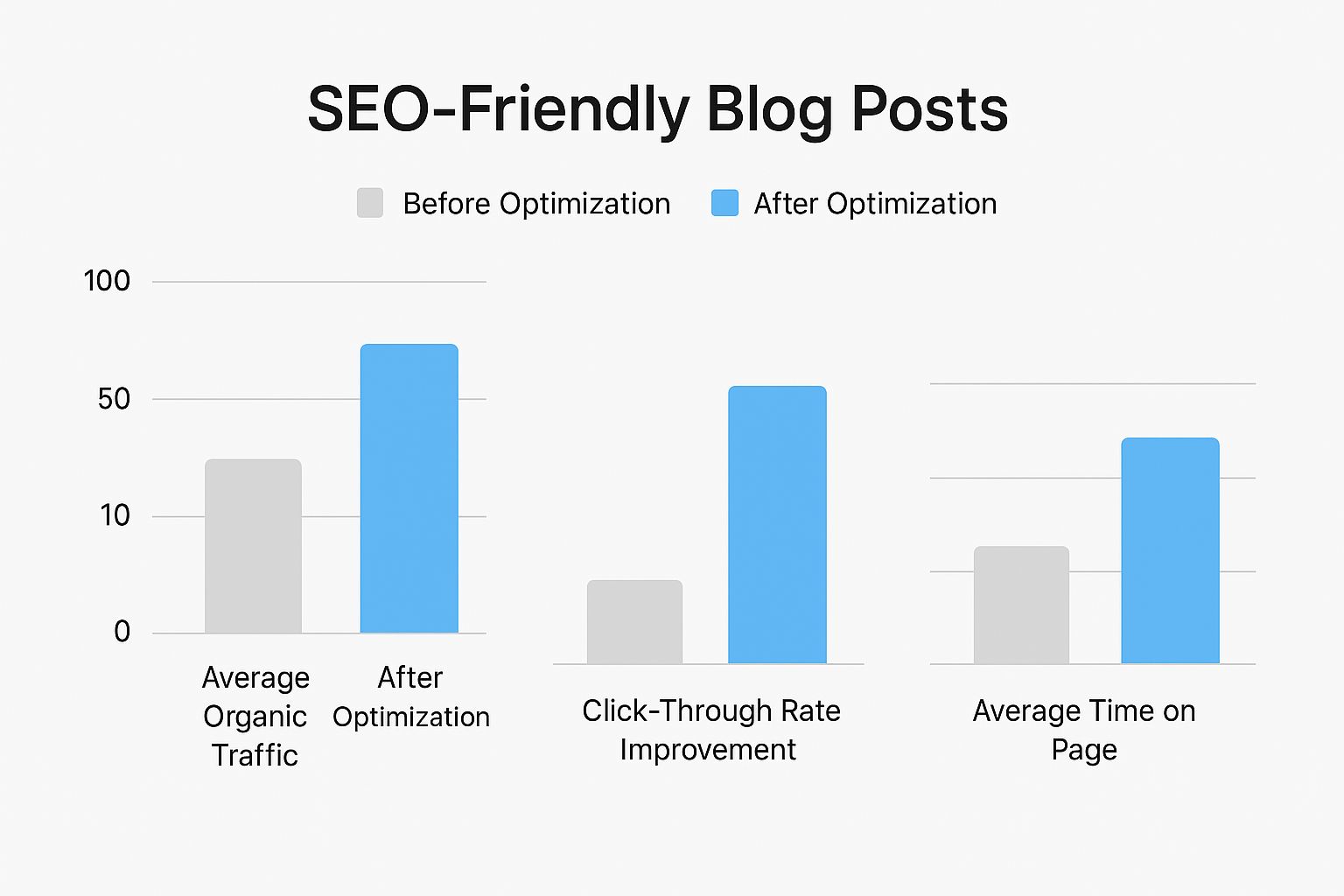How to Write SEO Friendly Blog Posts to Rank Higher

Writing an SEO-friendly blog post isn't just about stuffing keywords into your text. It’s about strategically picking your battles, truly understanding what your audience is asking for, and then building your content in a way that’s easy for both people and Google to read.
The goal is to create something valuable that directly answers a search query while also giving Google all the right signals through smart on-page optimization.
Building Your Foundation for SEO Success
Before you even think about writing, you need to lay the groundwork for a post that can actually rank. This is more than just grabbing a keyword that looks good on the surface. It's about digging in to figure out what your audience is searching for and, more importantly, why.
Your first job is to find a primary keyword that hits the sweet spot—enough people are searching for it, but the competition isn't impossible to beat. Then, you'll want to gather a bunch of related long-tail keywords. These are longer, more specific phrases that people use when they're deeper into their research and often closer to making a decision.
Align Your Content With Search Intent
Now for the most critical piece of the puzzle: search intent. You have to get inside the user's head and understand the "why" behind their search. Are they just looking for a quick answer? Are they comparing different options? Or are they ready to pull out their credit card?
Matching your content to that intent is everything. For instance, with 70% of search queries having informational intent, it's clear that most people are just looking for answers. This is a huge reason why formats like how-to guides and listicles are so dominant in search results. You can find more data on this by exploring the latest SEO statistics on SERanking.
The biggest mistake I see is a great article written for the wrong intent. A detailed product review will never rank for a search like "how to clean leather shoes," because Google knows the user wants a step-by-step guide, not a sales page.
Getting this alignment right has a real, measurable impact on performance. Just look at the difference it makes.
As you can see, a well-optimized post doesn't just rank higher—it gets more clicks and keeps people on the page longer. That's a massive signal to search engines that you're delivering value.
If you happen to be using AI tools to speed up your workflow, remember that maintaining a natural, human voice is crucial. It’s worth checking out our guide on how to humanize AI text to make sure your content doesn't sound robotic.
Crafting Content That Captivates and Converts
Alright, you've nailed down your keywords. Now for the fun part: writing an article that actually delivers. This is where the rubber meets the road—transforming your research into a piece of content that solves a reader's problem so well they have no reason to click back to Google.
Think of your post as the definitive guide on the topic. Your mission isn't just to answer a question, but to provide the single best answer out there. That means going deeper than your competitors, sharing unique insights, and making sure your article is an absolute breeze to read.
Building an Authoritative Resource
To write SEO-friendly blog posts that truly rank, you need to establish authority. It all starts with creating comprehensive content that covers a topic from every conceivable angle. It might sound a bit backward in our world of shrinking attention spans, but long-form content consistently comes out on top.
The data doesn’t lie: Comprehensive content signals expertise and value to both your readers and the search engines. Your job is to create the one-stop shop for anyone searching your target query.
For instance, blog posts with more than 3,000 words tend to dominate shorter articles. They can pull in up to three times more traffic, get four times more shares, and earn 3.5 times more backlinks simply because they satisfy user intent so completely. You can dig into more of these fascinating SEO performance statistics on AIOSEO. This isn’t a license to add fluff, of course. It’s about being exhaustive.
Structuring Content for Readability and SEO
A brilliant article is more than just great words on a page; presentation is everything. A massive wall of text is a surefire way to make readers bounce. You have to structure your content for scannability and create a smooth reading experience.
Here’s the simple framework I use for every single post to maximize its impact:
- Use Short Paragraphs: I stick to a strict 1-3 sentence limit per paragraph. This creates plenty of white space, making the content feel much less intimidating, especially on a phone.
- Leverage Headings: Your main title gets the H1 tag. Use H2s for your major sections and H3s for the sub-points within them—just like in this article. This builds a clear, logical hierarchy that helps Google understand what your content is about.
- Weave Keywords Naturally: Your primary keyword should be in your H1 title, at least one H2 heading, and somewhere in the first 100 words. From there, sprinkle your secondary keywords and related phrases throughout the body and other subheadings wherever they feel natural and make sense.
Executing Flawless On-Page SEO
Even the most brilliant writing will get lost in the digital noise if Google can't figure out what it's about. This is where on-page SEO comes into play. It’s all about giving search engines the right technical signals—think of them as signposts that guide crawlers to understand your content and why it deserves that coveted spot on page one.
Think of your title tag and meta description as your digital billboard on the search results page. Your title tag, which absolutely must include your primary keyword, is arguably the single most important on-page factor. It has to be compelling enough to steal the click from your competitors. While the meta description doesn't directly influence rankings, a well-crafted one can make a huge difference in your click-through rates.
Optimizing Your Digital Footprint
Beyond the title, every piece of your post's structure sends a signal to Google. One of the simplest yet most effective tweaks you can make is creating clean, descriptive URLs.
Instead of a clunky, auto-generated URL like yourblog.com/p=123, you want something that tells both people and search engines exactly what the page is about. A clean, keyword-rich URL like yourblog.com/how-to-write-seo-friendly-blog-posts is instantly more informative and user-friendly.
And please, don't forget about your images. Every single image needs descriptive alt text. This isn't just a box to check; it serves two critical functions:
- It makes your content accessible to people using screen readers.
- It gives Google context, helping your images show up in Google Image Search and drive more traffic to your site.
On-page SEO is really about making it incredibly easy for search engines to see your value. Each element, from the URL to alt text, is another chance to reinforce your topic and relevance.
Finally, let's talk about links. Internal links pointing to other relevant articles on your own site are fantastic for keeping readers engaged and spreading "link juice" or authority throughout your domain. At the same time, linking out to reputable, authoritative sources (external links) shows that you've done your homework. For a much deeper dive on getting this all right, check out this excellent guide on how to optimize content for SEO to achieve higher rankings.
Make Your Posts a Breeze to Read with Smart Formatting
Have you ever landed on a blog post, seen a massive wall of text, and immediately hit the back button? We all have. A huge block of text is the fastest way to lose a reader, no matter how good your content is.
Strategic formatting isn’t just about making your page look pretty. It's a huge part of writing SEO-friendly blog posts because it directly impacts engagement and how long people stay on your page—these are key signals that tell Google your content is hitting the mark. Your layout needs to work just as hard as your words do.
Design for Scannability
Let's be real: people don't read online; they scan. They're hunting for the specific piece of information they need. Smart formatting guides their eyes right to it, which encourages them to stick around and actually read.
A few simple tricks can make a world of difference:
- Bulleted and Numbered Lists: These are perfect for breaking down steps, features, or key takeaways. It’s so much easier to digest a list than to dig the same info out of a dense paragraph.
- Blockquotes for Punch: Got a killer statistic or a powerful insight? Pull it out into a blockquote. It immediately draws the eye and hammers home your most important messages.
The visual presentation of your blog post is just as important as the text itself. If you're looking for some fresh inspiration, you'll find some excellent blog layout ideas to get your creative juices flowing.
I’ve always believed that a human-first approach is the best SEO strategy. When you create something that genuinely helps your audience, you naturally start checking all the boxes that search engines love.
This focus on the reader's experience is precisely what Google wants to see. A well-formatted, visually engaging post tells search engines that people find your content valuable. And while AI tools can definitely speed up the writing process, you still need to put in the work to refine the output and make sure it’s genuinely engaging for a human reader. We’ve got some great tips on this in our guide on how to make AI writing more human.
Promoting Your Post for Lasting Impact
Here’s a hard truth: hitting 'publish' isn't the finish line. It’s the starting gun. A brilliantly crafted, SEO-friendly blog post won't go anywhere without a solid promotion strategy to give it that initial push and build long-term authority.
Your job isn't done until you've actively put your new content in front of the people who need to see it. This means sharing it where your audience already hangs out—send it to your email list, post it across your social channels, and look for opportunities to syndicate or repurpose it.
Promotion is what separates a good blog post from a great one. You’ve invested time creating a valuable resource; now you need to ensure it gets seen by the right people.
For lasting SEO success, you also have to think about authority. This is where strategic outreach comes in, especially the crucial work of earning quality backlinks from other reputable sites in your niche.
Measure What Matters
The final piece of the puzzle is tracking your performance. This data-driven approach is how you turn a single article into an asset that keeps driving traffic month after month.
You don't need a complex analytics setup to get started. The free tools at your disposal are incredibly powerful, and your first stop should be Google Search Console. Keep a close eye on these key metrics for any new post:
- Impressions: How many times your post showed up in search results.
- Organic Clicks: The number of people who actually clicked through to your site.
- Click-Through Rate (CTR): The percentage of impressions that turned into a click. A low CTR might mean your title or meta description needs a rewrite.
- Keyword Rankings: The specific queries your post is starting to rank for. This can reveal some surprising opportunities.
Analyzing this data tells you exactly what’s working and what isn't. It's how you refine your strategy over time. For instance, if you're using AI to help create content, you must know how to use AI without plagiarizing to protect your site's authority and ensure your hard work pays off.
Got SEO Blogging Questions? We've Got Answers
Even after you get the hang of writing SEO-friendly blog posts, a few questions always seem to come up. It's totally normal. Let's tackle these common hangups so you can feel confident every time you hit "publish."
So many writers get stuck on the numbers, wondering about the perfect word count or how many keywords to cram in. But here's the thing: while there are solid guidelines, the real secret is to always, always serve the reader first.
How Long Should an SEO Blog Post Be?
There isn't a magic number, but the data doesn't lie: longer, more in-depth content tends to crush it in the SERPs. As a rule of thumb, I always shoot for a minimum of 1,500 words to make sure I’m covering a topic from all angles. Honestly, posts that stretch over 3,000 words often see the best results in both traffic and shares.
But don't just write to hit a number. Quality will always beat quantity. Your main job is to completely solve the user's problem, whether that takes you 1,200 words or 4,000. A short post that gives a perfect answer is way better than a long one that just rambles on.
How Many Keywords Should I Use?
Keep it simple. Focus on one primary keyword and then sprinkle in about 3-5 related secondary keywords or long-tail versions throughout your post. The real art is weaving them—along with synonyms and related ideas—into your writing so it sounds completely natural.
Write for your audience first, and you'll find the keywords just seem to fall into place. Whatever you do, don't force them in. "Keyword stuffing" is a surefire way to get on Google's bad side.
Should I Write for Search Engines or People?
People. Always, 100% of the time, write for people first.
Think about it: Google's algorithms are incredibly sophisticated now. They're built to recognize and reward content that gives users the best possible experience.
When you focus on creating valuable, well-organized content that genuinely helps your reader, you naturally start ticking all the right SEO boxes. A human-first approach isn't just a nice idea—it's the smartest SEO strategy you can have. And as AI tools get more popular, keeping that authentic human touch is more important than ever. You can learn more by checking out our guide on how to avoid AI detection in writing.
Ready to create high-quality, authentic content that ranks? Word Spinner helps you rewrite, humanize, and generate original text that bypasses AI detectors and resonates with your audience. Start your free trial today!



